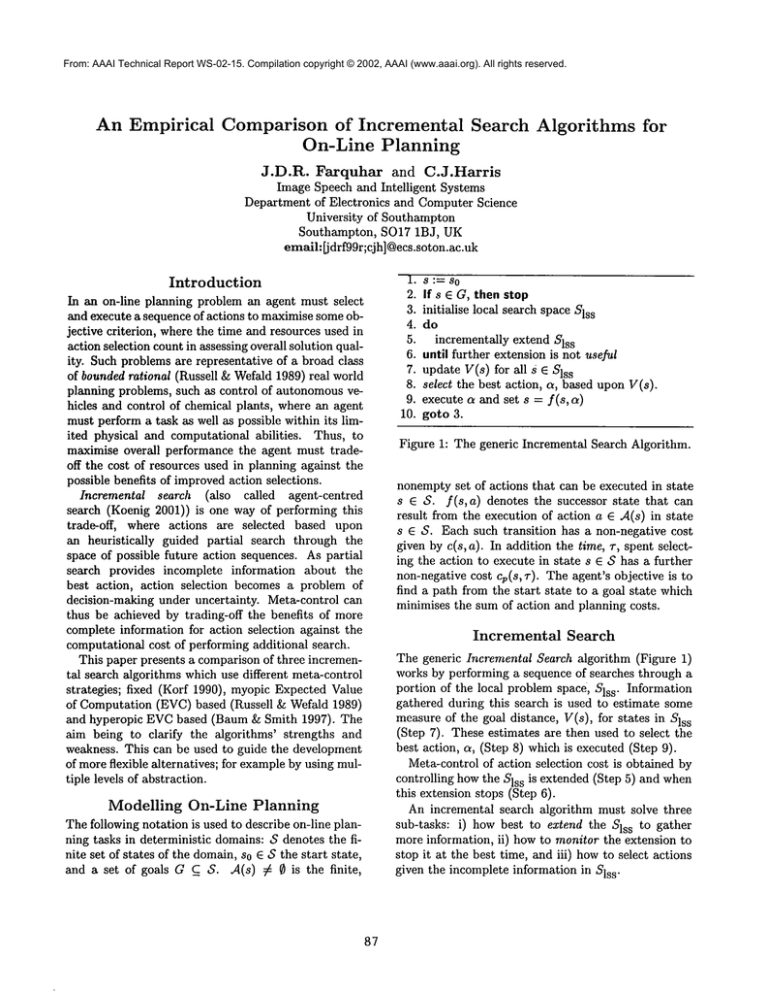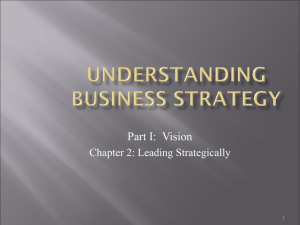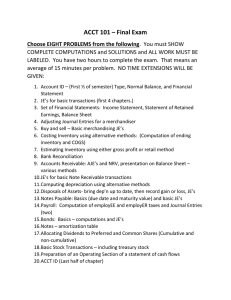
From: AAAI Technical Report WS-02-15. Compilation copyright © 2002, AAAI (www.aaai.org). All rights reserved.
An Empirical
Comparison of Incremental
On-Line Planning
Search Algorithms
for
J.D.R.
Farquhar
and C.J.Harris
Image Speech and Intelligent Systems
Department of Electronics and Computer Science
University of Southampton
Southampton, SO17 1B J, UK
email: [j drf99r;cjh]@ecs.soton.ac.uk
Introduction
In an on-line planning problem an agent must select
and execute a sequence of actions to maximisesome objective criterion, where the time and resources used in
action selection count in assessing overall solution quality. Such problems are representative of a broad class
of bounded rational (Russell & Wefald 1989) real world
planning problems, such as control of autonomous vehicles and control of chemical plants, where an agent
must perform a task as well as possible within its limited physical and computational abilities.
Thus, to
maximise overall performance the agent must tradeoff the cost of resources used in planning against the
possible benefits of improvedaction selections.
Incremental search (also called agent-centred
search (Koenig 2001)) is one way of performing this
trade-off,
where actions are selected based upon
an heuristically
guided partial search through the
space of possible future action sequences. As partial
search provides incomplete information about the
best action, action selection becomes a problem of
decision-making under uncertainty. Meta-control can
thus be achieved by trading-off the benefits of more
complete information for action selection against the
computational cost of performing additional search.
This paper presents a comparison of three incremental search algorithms which use different meta-control
strategies; fixed (Korf 1990), myopic Expected Value
of Computation (EVC) based (Russell & Wefald 1989)
and hyperopic EVCbased (Baum & Smith 1997). The
aim being to clarify the algorithms’ strengths and
weakness. This can be used to guide the development
of more flexible alternatives; for exampleby using multiple levels of abstraction.
Modelling On-Line Planning
The following notation is used to describe on-line planning tasks in deterministic domains: S denotes the finite set of states of the domain, So E S the start state,
and a set of goals G C S. A(s) ~ is the fini te,
87
].
0
2.
3.
s
4.
5.
s
6.
7.
8.
9.
10.
8:=8
If s E G, then stop
initialise local search space Sis
do
incrementally extend Sis
until further extension is not useful
update V(s) for
s all s e Sls
select the best action, a, based upon V(s).
execute a and set s = f(s, a)
goto 3.
Figure 1: The generic Incremental Search Algorithm.
nonemptyset of actions that can be executed in state
s E S. f(s,a) denotes the successor state that can
result from the execution of action a E A(s) in state
s E S. Each such transition has a non-negative cost
given by c(s, a). In addition the time, T, spent selecting the action to execute in state s E $ has a further
non-negative cost cp(s, T). The agent’s objective is
find a path from the start state to a goal state which
minimises the sum of action and planning costs.
Incremental
Search
The generic Incremental Search algorithm (Figure 1)
works by performing a sequence of searches through a
portion of the local problem space, Sls s. Information
gathered during this search is used to estimate some
measure
of the goal distance, V(s), for states in Sls
s
(Step 7). These estimates are then used to select the
best action, a, (Step 8) which is executed (Step
Meta-control of action selection cost is obtained by
controlling howthe Sls s is extended (Step 5) and when
this extension stops (Step 6).
An incremental search algorithm must solve three
sub-tasks: i) how best to extend the Sls s to gather
more information, ii) howto monitor the extension to
stop it at the best time, and iii) howto select actions
given
the incomplete information in Sls
s.
Algorithms
Examined
Learning
Real-Time
A*
Korf’s (1990) Real-Time A* (RTA*) is the most
knownincremental search technique, variants of which
have been applied to a wide range of on-line problems
(see (Koenig 2001) for a review of applications).
uses a conventional heuristic search technique, such as
A* or branch and bound, to generate the Sls s. The
heuristic estimates at the boundaryof Slss are taken as
actual goal distance estimates, V(s), for the purposes
of action selection. Learning RTA*improves on RTA*
by storing each state’s goal distance estimate, V(s),
which is used and updated in subsequent incremental
searches - improving action selection as the V(s) converge towards their true values.
Many meta-control strategies
are possible with
(L)RTA*.In this work the effort allocated to each incremental search is fixed, for example by limiting the
number of nodes examined, or the search depth.
information about the true value of each state. Baum
and Smith (1997) show how AVH can be computed
(assuming rational action selection) using a probability product formula.
AVHcan be used directly for monitoring when to
stop Sis s extension, i.e. continue if AVH--Cp(s,g)>O,
where g represents a number of extensions. Further,
the expected change in AVH is a good measure of a
computation’s contribution to the value of perfect information, and hence is a valid criterion upon which to
select computations. Baumand Smith (1997) further
show how to compute an approximation to this change
rapidly using influence function techniques.
Computing AVH and its expected change can still
be costly. Hence, as for DTA*,these values are only
calculated fully after a number of computations, g. Between re-calculations computations are ordered using
the old values.
Experimental
Analysis
These three algorithms represent a range of solutions
to the problem of intelligent on-line control. LRTA*
is simple and fast with little meta-control overhead.
Myopic EVChas higher overhead’s but should make
better use of its time. Hyperopic EVCis the most
complex but "thinks" further into the future.
The experimental analysis aims to identify when
more complex meta-control and longer term thinking
are worthwhile. This will be achieved by comparing
the algorithms using the same heuristic estimates and
problem representation over a range of on-line planning
problems of varying complexities, and timeliness requirements, determined by the ratio of action to planning costs, c(s, a)/Cp(S, 1).
Unfortunately, the analysis was not complete at time
of press. Full results will be available at the conference.
Myopic
EVC
Horvitz (1990) developed an meta-control method
based on the expected value of computation (EVC),
which is defined as the expected improvement in decision quality which results from performing a computation, taking into account its costs. Assumingthe EVC
is available for free an optimal meta-control strategy is
to perform the computation with maximal EVCuntil
the EVC< 0. Unfortunately, exact computation of the
EVCrequires consideration of all possible future action
selections and monitoring decisions. Hence, estimates
for EVCmust be used.
A myopic estimate for the EVC, AVM, is computed
by assuming that the next computation, c, is the last,
after which all further action selections are fixed (1).
AVM(c) = [ ~ Pr(aj[c)V(aj)
J
V(a)] -
%(s, c)
References
Baum, E. B., and Smith, W. D. 1997. A Bayesian
approach to relevance in game playing. Artificial Intelligence 97:195-242.
where Via) is the estimated value of a, a is the current
best action, Pr(aj[c) is the probability of c resulting
in a new best action aj and Cp(S, c) is the cost of
Computing AVM(c)can still be costly. Hence,
use the meta-control strategy used in Russell and
Welfald’s (1989) DTA*algorithm. This calculates
AVM(c)fully
after a number of computations, i.e. Sls
s
extensions, proportional to ISlss[. Computations are
ordered using both heuristic and AVM(c) estimates.
Horvitz, E. 1990. Computation and action under
bounded resources. Ph.D. Dissertation, Stanford University.
Koenig, S. 2001. Agent-centered search. Artificial
Intelligence Magazine 22(2):109-131.
Korf, R. E. 1990. Real-time heuristic search. Artificial
Intelligence 42:1189-211.
Hyperopic
EVC
The opposite of a myopic EVCestimate is a hyperopic
one, AVH,where it is assumed that all possible future
computations are performed for free before action selection. This corresponds to the value of having perfect
Russell, S., and Wefald, E. 1989. Do the right thing:
Studies in Limited Rationality. The MITPress.
88




